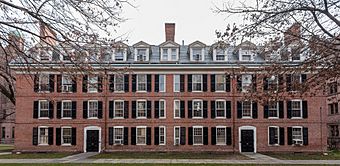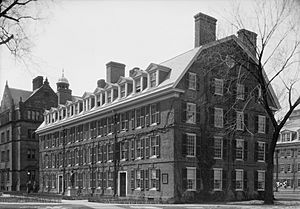Connecticut Hall facts for kids
|
Connecticut Hall
|
|

Connecticut Hall
|
|
| Location | 1017 Chapel Street New Haven, Connecticut, United States |
|---|---|
| Built | 1752 |
| Architect | Francis Letort, Thomas Bills |
| Architectural style | Georgian |
| Restored | 1952 |
| Restored by | Douglas Orr |
| NRHP reference No. | 66000806 |
Quick facts for kids Significant dates |
|
| Added to NRHP | October 15, 1966 |
| Designated NHL | December 21, 1965 |
Connecticut Hall (also known as South Middle College) is a historic building at Yale University in New Haven, Connecticut. It was built in 1752 in the Georgian style. For 200 years, it was a home for students.
Today, Connecticut Hall is used by Yale's Department of Philosophy. The third floor has a special room for meetings of Yale's professors. This building is one of the oldest college buildings still standing in the United States. It is also the second-oldest building built for Yale College in New Haven. In 1965, it was named a National Historic Landmark. This means it's a very important historical place.
Contents
History of Connecticut Hall
Building the First Dormitory
When Yale College moved to New Haven in 1718, they had a wooden building called the College House. By 1747, this building was too small for all the students. Yale's president, Thomas Clap, decided to build a "new College House."
Money for the new building came from different places. Some funds came from selling a French ship captured by a privateer. A lottery also helped, along with a grant from the Connecticut Assembly.
Construction finished in 1752. Francis Letort and Thomas Bills led the building work. They also designed Yale's next building, the First Chapel. The new dormitory was about 100 feet long and 40 feet wide. It had three stories.
President Clap wanted the building to look like Massachusetts Hall at Harvard University. Massachusetts Hall was built in 1720. So, Connecticut Hall looked almost exactly like it. Originally, it had nearly 100 rooms under its unique gambrel roof.
Old Brick Row and Its Legacy
Connecticut Hall became the first building in a campus plan called "Old Brick Row." As more buildings were added, Connecticut Hall became known as South Middle College. By 1824, Old Brick Row had four similar "colleges."
In the early 1900s, Old Brick Row was planned to be torn down. However, a group of Yale alumni, led by Professor Henry W. Farnam, saved Connecticut Hall. It is the only building left from that original row.
In 1925, Yale started building McClellan Hall. This new dormitory was meant to look like Connecticut Hall. It would balance Connecticut Hall on the campus. Many students and professors did not like this idea. They felt Connecticut Hall was old and spoiled the campus's look. They called McClellan "Hush Hall" and protested its construction.
Changes Over Time
Connecticut Hall has been changed several times over the years. In 1797, the gambrel roof was replaced with a fourth story and a pitched roof. This made the building look different.
In 1905, a restoration project led by Grosvenor Atterbury brought back the gambrel roof. This made the building look more like its original design. From 1952 to 1954, the inside of the building was completely rebuilt. It was changed to have rooms for reading, seminars, and faculty offices.
Uses of Connecticut Hall
Connecticut Hall was a student dormitory for almost 200 years. But it also had other uses.
Early Uses
Because there wasn't enough space, professors like Thomas Clap held classes in the building's entryways. Before other buildings were built, Connecticut Hall also housed a physics lab. It even had an art gallery and a collection of natural history items.
In the mid-1700s, a "buttery" was located on the first floor. This was like a small shop for students. They could buy drinks like beer and cider, and seasonal fruits. One Yale historian said it was a place for students to gather and chat. The buttery closed in 1817.
As a place to live, South Middle (Connecticut Hall) was known for being small, damp, and cold. Many students living there did not like it very much.
Modern Uses
After the 1905 restoration, Yale College Dean Frederick S. Jones moved his offices into Connecticut Hall. He wanted to be "at the center of the college." His offices stayed there until World War II.
Later, the building was fully changed into offices for different departments and meeting spaces for professors. Today, Connecticut Hall holds the offices for Yale's Department of Philosophy. The Faculty Room, where the professors of Arts and Sciences have their meetings, is on the second floor. There is also a computer cluster in the basement.
Architectural Importance
Connecticut Hall is one of the oldest buildings in Connecticut. It is the only example of colonial-era architecture still standing at Yale.
It was named a National Historic Landmark in 1965. This shows its importance in American history and architecture. The first two dorms at Miami University in Oxford, Ohio, were even designed to look like Connecticut Hall.


